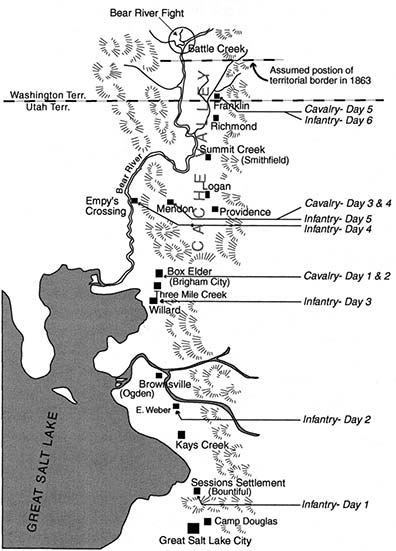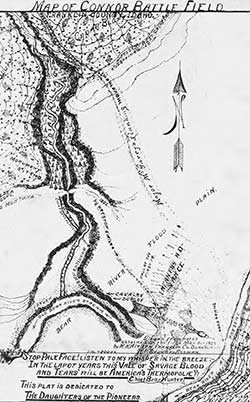Official Report of the Battle of Bear River

Headquarters District of Utah
Camp Douglas, Utah Territory, February 6th, 1863
Colonel: I have the honor to report that from information received from various sources of the encampment of a large body of Indians on Bear River, in Utah Territory, one-hundred forty miles north of this point, who have murdered several miners during the winder, passing to and from the settlements in this valley to the Beaver Head mines, east of the Rocky Mountains, and being satisfied that they were a part of the same band who had been murdering emigrants on the Overland Mail Route for the last fifteen years and the principal actors and leaders in the horrid massacres of the past summer, I determined, although the season was unfavorable to an expedition in consequence of the cold weather and deep snow, to chastise them if possible. Feeling assured that secrecy was the surest way to success, I determined to deceive the Indians by sending a small force in advance, judging and rightly, they would not fear a small number. On the 22nd ultimo I ordered Company K, Third California Volunteers, Captain Hoyt, two howitzers, under the command of Lieutenant Honeyman and twelve men of the Second Cavalry California Volunteers, with a train of fifteen wagons, carrying twenty days' supplies, to proceed in that direction.
On the 24th ultimo I proceeded with detachments from Companies A, H, K and M, Second Cavalry California Volunteers, numbering two-hundred twenty men, accompanies by Major McGarry, Second California Volunteers; Surgeon Reid, Third Infantry California Volunteers; Captains McLean and Price and Lieutenants Chase, Clark, Quinn and Conrad, Second Cavalry California Volunteers; Major Gallagher, Third Infantry California Volunteers and Captain Berry, Second Cavalry California Volunteers, who were present at this post attending general court-martial, as volunteers.

I marched the first night to Brigham City, sixty-eight miles distant. The second night's march from Camp Douglas I overtook the infantry and artillery at the town of Mendon and ordered them to march again that night. I resumed my march with the cavalry and overtook the infantry at Franklin, Utah Territory, about twelve miles from the Indian encampment. I ordered Captain Hoyt, with the infantry, howitzers and train, to move at one o'clock the next morning, intending to start with the cavalry about two hours thereafter, in order to reach the Indian encampment at the same time and surround it before daylight, but in consequence of the difficulty in procuring a guide to the ford of the river, Captain Hoyt did not move until after three a.m.
I moved the cavalry in about one hour afterward, passing the infantry, artillery and wagons about four miles from the Indian encampment. As daylight was approaching, I was apprehensive that the Indians would discover the strength of my force and make their escape. I therefore made a rapid march with the cavalry and reached the bank of the river shortly after daylight in full view of the Indian encampment and about one mile distant.
I immediately ordered Major McGarry to advance with the cavalry and surround before attacking them, while I remained a few minutes in the rear to give orders to the infantry and artillery. On my arrival on the field I found that Major McGarry had dismounted the cavalry and was engaged with the Indians who had sallied out of their hiding places on foot and horseback and with fiendish malignity waved the scalps of white women and challenged the troops to battle, at the same time attacking them. Finding it impossible to surround them, in consequence of the nature of the ground, he accepted their challenge.
The position of the Indians was one of the strong natural defenses and almost inaccessible to the troops, being in a deep, dry ravine from six to twelve feet deep and from thirty to forty feet across level tableland, along which they had constructed steps from which they could deliver their fire without being themselves exposed. Under the embankments they had constructed artificial covers of willows thickly woven together, from behind which they could fire without being observed.
After being engaged about twenty minutes I found it was impossible to dislodge them without great sacrifice of life. I accordingly ordered Major McGarry with twenty men to turn their left flank, which was in the ravine where it entered the mountains. Shortly afterward Captain Hoyt reached the ford three-quarters of a mile distant, but found it impossible to cross footmen. Some of them tried it, however, rushing into the river, but finding it deep and rapid, retired. I immediately ordered a detachment of cavalry with lead horses to cross the infantry, which was done accordingly and upon their arrival upon the field I ordered them to the support of Major McGarry's flanking party, who shortly afterward succeeded in turning the enemy's flank. Up to this time, in consequence of being exposed on a level and open plain while the Indians were under cover, they had every advantage of us, fighting with the ferocity of demons. My men fell fast and thick around me, but after flanking them we had the advantage and made good use of it.
I ordered the flanking party to advance down the ravine on either side, which gave us the advantage of an enfilading fire and caused some of the Indians to give way and run toward the north of the ravine. At this point I had a company stationed, who shot them as they ran out. But few tried to escape, however, but continued fighting with unyielding obstinacy, frequently engaging hand to hand with the troops until killed in their hiding places. The most of those who did escape from the ravine were afterward shot in attempting to swim the river, or killed while desperately fighting under cover of the dense willow thicket which lined the river banks.
To give you an idea of the desperate character of the fight, you are respectfully referred to the list of killed and wounded transmitted herewith. The fight commenced about six o'clock in the morning and continued until about ten. At the commencement of the battle the hands of some of the men were so benumbed with cold that it was with difficulty they could load their pieces. Their suffering during the march was awful beyond description, but they steadily continued on without regard to hunger, cold, or thirst, not a murmur escaping them to indicate their sensibilities to pain or fatigue. Their uncomplaining endurance during their four nights' march from Camp Douglas to the battlefield is worthy of the highest praise. The weather was intensely cold and not less than seventy-five had their feet frozen and some of them I fear will be crippled for life.
I should mention here that in my march from this post, no assistance was rendered by the Mormons, who seemed indisposed to divulge any information regarding the Indians and charged enormous prices for every article furnished my command. I also have to report to the general commanding that previous to my departure Chief Justice Kinney, of Great Salt Lake City, made a requisition for troops for the purpose of arresting the Indian chiefs Bear Hunter, San Pitch, and Sagwitch. I informed the marshal that my arrangements for our expedition against the Indians were made and that it was not my intention to take any prisoners, but that he could accompany me. Marshal Gibbs accordingly accompanied me and rendered efficient aid in caring for the wounded.

I take great pleasure in awarding to Major McGarry, Second Cavalry Cavalry California Volunteers; Major Gallagher and Surgeon R.K. Reid, Third Infantry California Volunteers, the highest praise for their skill, gallantry and bravery throughout the engagement, and to the company officers the highest praise is due without invidious distinction for their bravery, courage and determination evidenced throughout the engagement. Their obedience to orders, attention, kindness and care for the wounded is no less worthy of notice. Of the good conduct and bravery of both officers and men California has reason to be proud. We found two-hundred twenty-four bodies on the field, among which were those of the chiefs Bear Hunter, Sagwitch, and Leight. How many more were killed than stated I am unable to say, as the condition of the wounded rendered their immediate removal a necessity. I was unable to examine the field.
I captured one-hundred seventy-five horses, some arms, destroyed over seventy lodges, a large quantity of wheat and other provisions, which had been furnished them by the Mormons; left a small quantity of wheat for the sustenance of one-hundred sixty captive squaws and children, whom I left on the field. The chiefs Pocatello and San Pitch, with their bands of murderers, are still at large. I hope to be able to kill or capture them before spring. If I succeed, the Overland Route west of the Rocky Mountains will be rid of the bedouins who have harassed and murdered emigrants on that route for a series of years. In consequence of the number of men left on the route with frozen feet and those with the train and howitzers and guarding the cavalry horses, I did not have to exceed two-hundred men engaged. The enemy had about three-hundred warriors, mostly well armed with rifles and having plenty of ammunition, which rumor says they received from the inhabitants of this Territory in exchange for the property of massacred emigrants.
The position of the Indians was one of great natural strength and had I not succeeded in flanking them the mortality in my command would have been terrible. In consequence of the deep snow, the howitzers did not reach the field in time to be used in the action.1
I have the honor to remain, very respectfully, your obedient servant,
Colonel Third Infantry California Volunteers, Comdg. District.
Lieut. Col. R.C. Drum, U.S. Army, Assistant Adjust-General, Department of the Pacific.
Notes…
Patrick E. Connor's report of the military activity, leading up to the Battle of Bear River on the early morning of 29 January 1863. It is from this military action to chastise the Indians, that Cache Valley was able to move out from fort life, onto the city lots of most of the towns in Cache Valley. Also it was then that the west side of Cache Valley, Clarkston, Newton, Weston and Oxford settlements were undertaken. Prior to this, it was far too dangerous to live so far out in Indian country.
- MXXXXX, published by the Smithfield Sentinel, Friday, May 12, 1922.